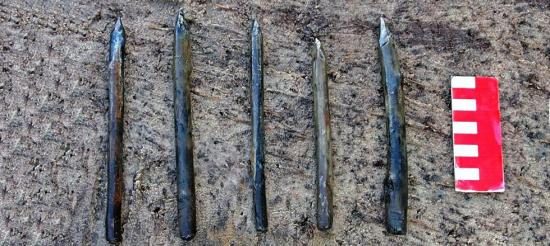PAP – Science and Scholarship in Poland
Source - http://www.pasthorizonspr.com/index.php/archives/09/2014/mesolithic-sanctuary-reveals-constellation-riddle?

Yew Stakes (10cm scale) - Photo. T. Galinski (via PAP)
Evidence for ritual and possible astronomical practices during the Mesolithic period, 9000 years ago, has been uncovered in Bolków by lake Świdwie, Western Pomerania, by archaeologists from the Institute of Archaeology and Ethnology in Szczecin, Poland.
Bundles of magic
This Mesolithic-era site recently became famous for the artefacts found at one particular hut. A number of possible shamanistic ritual objects along with a fragment of meteorite were discovered last year.
To add to this discovery, the archaeologists have investigated the remains of two further pine and aspen pole structures which would have stood to a height of some 1.5 metres (5 ft). Inside both of the structures were buried bundles of pine and birch bark, bunches of grass – Festuca ovina - as well as bone fragments from forest dwelling animals. Now the archaeologists are more certain than ever that this is a rare glimpse into the world of Mesolithic beliefs.
“These finds are eloquent, direct evidence for the beliefs and rituals of Mesolithic societies that were inextricably linked to the natural world of animals and plants on which they were dependant. The bundles contain key elements of the contemporary environment in which they moved”- says Prof. Tadeusz Galinski, head of research.
Ursa Major
In addition to the structures made of pine and aspen poles the archaeologists also found seven perfectly preserved yew stakes stuck into the ground on what can only be described as a very recognisable pattern. According to Prof. Galiński it seems plausible they reflect a part of what we now call the constellation of Ursa Major (the Great Bear) – the brightest of the stars that make up Ursa Major are known as the Big Dipper or Plough.

Ursa Major (inset: position of Yew stakes.) Main Image: Manfred Wassmann (Flickr, used under a CC BY-SA 3.0)
The possible astronomical discoveries in the camp in Bolków along with fragments of meteorite appear to further confirm the hypothesis that shamans played an important role within Mesolithic communities, developing an interest in the mysteries of the sky and the marking of time.
Further evidence for Mesolithic star gazing
In 2013 the University of Birmingham (UK) reported on the discovery of a Mesolithic pit alignment and therefore claimed the earliest evidence currently available for ‘time reckoning’. The pit group appears to mimic the phases of the Moon and is structured to track lunar months. The researchers stated in their report, “the evidence suggests that hunter-gatherer societies in Scotland had both the need and ability to track time across the year, and also perhaps within the month, and that this occurred at a period nearly five thousand years before the first formal calendars were created in Mesopotamia.”